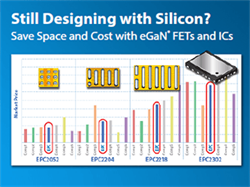Sign up today to get the latest news and updates from EPC on new product announcements, applications work, and much more. Sign up for EPC email updates.
Easy Engineering interviewed EPC’s Director of Marketing, Renee Yawger, on the current state of GaN adoption and the future of GaN technology.
Easy Engineering
May, 2022
Read article
Read more

One way to tell when a new technology has passed the tipping point of adoption is by the voices advocating the status quo. The more conservative voices tend to cite older information that, given the fast change of trajectory that occurs at a tipping point, can lead to poor decisions for new designs. In the world of GaN power devices the tipping point occurred in the past two years when the rate of new GaN-based designs started to double year-on-year, and the legacy MOSFET designs started to face critical supply shortages due to their finely tuned, but less flexible supply chains. GaN devices, on the other hand, have remained in stock at most major distributors due to their relatively new and flexible supply chains utilizing older silicon foundries, but affording these foundries a new and vibrant future. In this article we will address some of the common misconceptions still showing up in articles and at conferences, usually presented by advocates of the status quo.
Bodo’s Power Systems
May, 2022
Read article
Read more
The mainstream materials for wide-bandgap (WBG) semiconductor power components are silicon carbide (SiC) and gallium nitride (GaN). They become various power system applications' most-preferred devices today with the rising awareness of energy conservation and sustainability. This was the first time Tech Taipei 2022 Conference used WBG as its theme. Speakers from key players in the industry were invited from design, manufacturing and testing fields to share with over 400 participants at the conference their latest technology and application trends.
EE Times Taiwan
March 25, 2022
Read article
Read more
In this article, the most common reasons for some customers to be slower in their embracing what is clearly a displacement technology for their older silicon-based power MOSFETs will be discussed. Without going into the detailed statistics, a list of reasons, in order of frequency is derived. This list is based upon the understanding that some applications will place higher emphasis than others on certain characteristics of GaN. Our discussion is limited to devices rated at less than 400 V, as that is the application focus for Efficient Power Conversion (EPC) FET and IC products.
Power Systems Design
March, 2022
Read article
Read more
In the field of motion control, there is a growing use of GaN devices, especially in low voltage applications. This paper provides guidelines for designers on the optimal use of GaN FETs in motor control applications, identifying the advantages and discussing the main issues.
Energies Journal
October, 2021
Download and read article
Read more
Mature, low-cost manufacturing and proven reliability spur use in EVs, smartphones, and consumer electronics.
Efficient Power Conversion (EPC) has logged more than 100 emerging applications for its eGaN FETs and ICs. Alex Lidow, the company’s CEO, said the five fastest-growing applications are lidar systems for robotics, drones, consumer products, driver alertness systems, and autonomous vehicles; DC-DC converters for AI systems, servers, and telecom power systems; motor drives for e-mobility and robotics; satellite systems, including motor drives and DC-DC power supplies that require radiation hardness; and solar power point trackers.
Semiconductor Engineering
December, 2021
Read article
Read more
Today, the permanent magnet motor, also known as DC brushless motor (BLDC), is widely used and offers higher torque capability per cubic inch and higher dynamics when compared to other motors. So far, silicon-based power devices have been dominant in the inverter electronics, but today their performance is nearing their theoretical limits. There is an increasing need for higher power density. Gallium nitride (GaN) transistors and ICs have the best attributes to satisfy these needs.
Power Systems Design
November, 2021
Read article
Read more
This month has been a busy one in the FET space. Here are a few FETs from EPC, UnitedSiC, and Intel that depart from traditional silicon transistors in interesting ways.
All About Circuits
October, 2021
Read article
Read more

Over the past decade computers, displays, smart phones and other consumer electronics systems have become thinner while also becoming more powerful. As a result, the market continues to increase its demand for thinner power supply solutions with greater power density. This article examines the feasibility of adopting various non-isolated dc-dc step-down topologies for an ultra-thin 48 V to 20 V rated to 250 W. It examines the pros and cons of various non-isolated topologies and how the topology impacts the choice of the power transistors and magnetics, specifically the inductors, as these two components account for the bulk of the losses in a converter. The article also undertakes a detailed analysis of the challenges to design thin inductors for these applications, including examining the factors that drive inductor losses, inductor size, and the design tradeoffs, including the impact on EMI. For this work, an ultrathin multilevel converter topology was selected, built, and tested. The experimental results obtained from this converter were used to further refine the operating setting and component selections that resulted in a peak efficiency exceeding 98%.
Michael de Rooij, EPC
Quentin Laidebeur, Würth Elektronik
IEEE Power Electronics Magazine
September, 2021
(subscription required)
Read article
Read more
A roundtable discussion with GaN industry experts hosted by Bodo’s Power Systems. Guests included:
- Alex Lidow, CEO and co-founder of Efficient Power Conversion
- Doug Bailey, Vice President Marketing & Applications Engineering at Power Integrations
- Dilder Chowdhury, Director, Strategic Marketing, Power GaN Technology at Nexperia
- Tom Ribarich, Sr. Director Strategic Marketing at Navitas Semiconductor
Read more
In this article, the author introduces a GaN FET compatible analog controller that yields a low bill-of-material count and give designers the ability to design a synchronous buck converter in the same simple way as using silicon FETs, and offers superior performance for 48 V power systems.
Power Electronics News
April, 2021
Read article
Read more
Gallium nitride power device technology enables a new generation of power converters in space operating at higher frequencies, higher efficiencies, and greater power densities than everachievable before. GaN power devices can also exhibit superior radiation tolerance compared with Silicon MOSFETs depending upon their device design.
Power Electronics Europe
December, 2020
Read article
Read more
Discrete power transistors, whether silicon-based or GaN-on-silicon, are entering their final chapter. GaN-on-Si integrated circuits offer higher performance in a smaller footprint with significantly reduced cost and less engineering required. This article details how the ascent of GaN is redefining power conversion.
Bodo’s Power Systems
October, 2020
Read article
Read more
Just like life’s reality, when the aged leaves the center stage for the younger ones, Silicon is taking the bow. The advent and adoption of Gallium Nitride (GaN) have succeeded in gradually easing out the old reliable Silicon. For over four decades, power management efficiency and cost have improved steadily as innovations in power MOSFET structures, technology, and circuit topologies have kept pace with the growing need for electrical power. In the new millennium, however, the rate of improvement has slowed dramatically as the silicon power MOSFET approaches its theoretical bounds. At the same time, the new material, GaN is steadily progressing on its journey toward a theoretical performance boundary that is 6,000 times better than the aging silicon MOSFET and 300 times better than the best GaN products on the market today.
EEWeb
July 16, 2020
Read article
Read more
An integrated circuit made using GaN-on-Si substrates has been in production for over five years. The ultimate goal is to achieve a single component IC that merely requires a simple digital input from a microcontroller and produces a power output that drives a load efficiently, reliably under all conditions, in the smallest space possible, and economically. Discrete power transistors, whether silicon-based or GaN-on-Si, are entering their final chapter. Integrated GaN-on-Si can offer higher performance in a smaller footprint with significantly reduced engineering required.
IEEE Power Electronics Magazine
March 2020
Read article
Read more
Silicon power MOSFETs have not kept pace with the evolutionary changes in the power electronics industry where factors such as efficiency, power density, and smaller form factors are the main demands of the community. The power electronics industry has seen the theoretical limit of silicon MOSFETs reached and now needs to move to a new element. Gallium Nitride or GaN is a highly mobile semiconductor electron semiconductor (HEMT) that is proving to be a real added value in meeting new applications.
Power Electronics News
March 25, 2020
Read article
Read more

This article discussed an oft forgotten or little-noticed part of the spacecraft enabling travel into outer space---power management in the space vehicle. Wide bandgap semiconductors like gallium nitride (GaN), silicon carbide (SiC), as well as diamond, are looking to be the most promising materials for future electronic components since the discovery of silicon. These technologies, depending upon their design, offer huge advantages in terms of power capability (DC and microwave), radiation insensitivity, high temperature and high frequency operation, optical properties and even low noise capability. Therefore, wide bandgap components are strategically important for the development of next generation space-borne systems. eGaN devices are quickly gaining momentum in the space industry and we will see many more applications for them by NASA and commercial contractors in future programs like Artemis and other programs in countries around the globe pursuing efforts into Space.
Power Systems Design
November, 2019
Read article
Read more
Today’s GaN FETs are improving rapidly in size and performance. The benchmark devices are still 300 times away from their theoretical performance limits.
The early GaN adopters needed the speed. Big examples were lidar systems for autonomous cars, drones, and robots, and 4G/LTE base stations. The volume has grown, and now GaN power devices are at a point where the prices are equivalent to the slower, bigger and aging power MOSFET. Thus, it is time for GaN’s frontal assault!
Bodo’s Power Systems
June 2019
Read article
In this episode of PSDtv Alex Lidow, Chief Executive Officer and Co-Founder of Efficient Power Conversion (EPC) is at APEC 2019 in Anaheim and discusses why their GaN on Silicon devices make Silicon now dead.
PSDtv
View video
Last week, Anker debuted a tiny new power brick, crediting its small size with the component it uses instead of silicon: gallium nitride (GaN). It’s the latest example of the growing popularity of this transparent, glass-like material that could one day unseat silicon and cut energy use worldwide.
The Verge
Read article
Read more